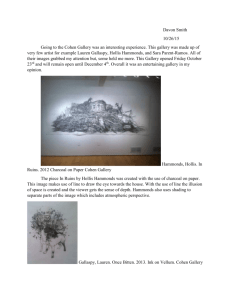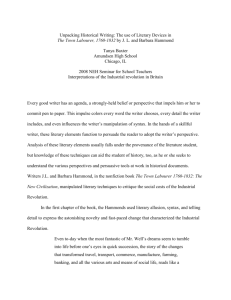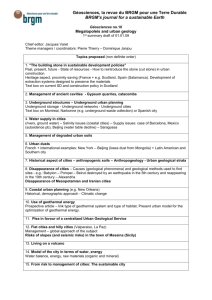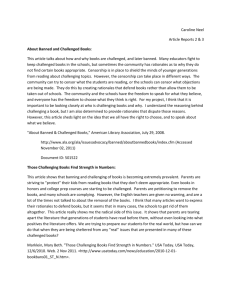Hammonds: 1) I would phrase the issue and narrow
advertisement
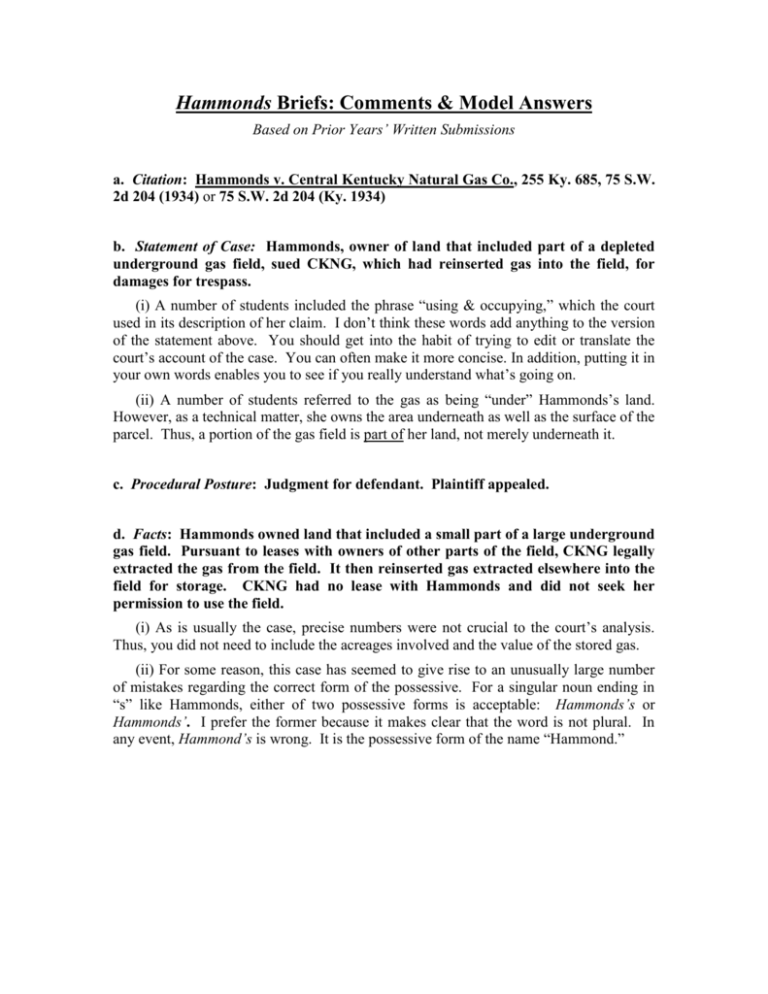
Hammonds Briefs: Comments & Model Answers Based on Prior Years’ Written Submissions a. Citation: Hammonds v. Central Kentucky Natural Gas Co., 255 Ky. 685, 75 S.W. 2d 204 (1934) or 75 S.W. 2d 204 (Ky. 1934) b. Statement of Case: Hammonds, owner of land that included part of a depleted underground gas field, sued CKNG, which had reinserted gas into the field, for damages for trespass. (i) A number of students included the phrase “using & occupying,” which the court used in its description of her claim. I don’t think these words add anything to the version of the statement above. You should get into the habit of trying to edit or translate the court’s account of the case. You can often make it more concise. In addition, putting it in your own words enables you to see if you really understand what’s going on. (ii) A number of students referred to the gas as being “under” Hammonds’s land. However, as a technical matter, she owns the area underneath as well as the surface of the parcel. Thus, a portion of the gas field is part of her land, not merely underneath it. c. Procedural Posture: Judgment for defendant. Plaintiff appealed. d. Facts: Hammonds owned land that included a small part of a large underground gas field. Pursuant to leases with owners of other parts of the field, CKNG legally extracted the gas from the field. It then reinserted gas extracted elsewhere into the field for storage. CKNG had no lease with Hammonds and did not seek her permission to use the field. (i) As is usually the case, precise numbers were not crucial to the court’s analysis. Thus, you did not need to include the acreages involved and the value of the stored gas. (ii) For some reason, this case has seemed to give rise to an unusually large number of mistakes regarding the correct form of the possessive. For a singular noun ending in “s” like Hammonds, either of two possessive forms is acceptable: Hammonds’s or Hammonds’. I prefer the former because it makes clear that the word is not plural. In any event, Hammond’s is wrong. It is the possessive form of the name “Hammond.” e. Issue/Holding Did the lower court err in granting judgment for defendant on the grounds that parties who have natural gas in their possession and release it into a natural underground basin do not retain property in the gas and therefore do not commit trespass when the gas travels onto land owned by another? (i) Narrow Holding: NO. The lower court did not err in granting judgment for defendant because parties who have natural gas in their possession and release it into a natural underground basin do not retain property in the gas and therefore do not commit trespass when the gas travels onto land owned by another. (ii) Possible Broad Holding: Where parties have liquid or gaseous minerals in their possession and release them underground into areas that formerly contained that mineral, they do not retain property in the mineral. (iii) Be careful about buying too far into the court’s use of the animals metaphor. For example, many students gave as the issue the court’s “question” about whether the gas “was restored to its original wild and natural status.”1 Whether gas has become “wild and natural” hardly seems to be a legal question. I think it is important that you try to distance yourself from the court’s more colorful language and try to figure out what is really at stake, which is, “Who owns gas that is reinserted into the ground?” (iv) Some students listed as a holding that Hammonds was “the absolute owner” of the gas underneath the area of the surface she owned, relying on the Mills & Willingham citation. However, the text refers to gas that has not yet been extracted and states that the gas can be lost through “escape,” when a neighbor withdraws the gas from a well on an adjoining lot.2 Thus, the passage doesn’t tell you what happens when the gas is first possessed and then reinserted. Moreover, this was unlikely to be the holding in a case where nobody argued that Hammonds owned the gas. She argued that it belonged to the gas company and the gas company argued that it belonged to nobody. (v) A number of students mixed rationales into the holdings both here and in the White briefs. A holding generally takes the form of a legal rule: “Where X facts are present, Y legal result follows. If you find yourself adding a clause that begins, “because,” you probably are drifting into the rationales. Similarly, several students repeated that the gas “wandered onto” Hammonds’s land. The gas company deliberately placed the gas into a reservoir, part of which she owned. The gas predictably spread throughout the reservoir including Hammonds’s part of it. The case is different in that sense than Albers or Kesler, where the owners could reasonably assert that they had no idea where the fox would go once it escaped. 2 The ownership interest described here is the kind of contingent interest that landowners get in animals on their land through the doctrine of ratione soli. 1 f. Rationales: (i) Doctrinal Rationales (A) Gas is like animals. Westmoreland; Willis treatise. When animals escape into their natural element, they return to their unowned state. The same should be true of gas. (B) Gas is also like underground water. If you pull water out of the ground it is yours. If you return it into the ground, you lose property rights. Willis treatise. Hill. Rock Creek. The same should be true of gas. (C) When gas is returned to underground storage, it is taxed as part of the land, not as separate personal property of the surface owner. Willis treatise. This suggests that the property rights in the gas are the same as those in gas that has never been extracted: the owner of the surface, not the company that reinserted it, has ownership rights unless the gas is legally extracted by another.3 (ii) Possible Policy Rationales: (A) The court may have been unfavorably inclined toward Hammonds because it may have perceived that she was trying to make easy money where she had not exerted labor nor experienced harm. The holding would prevent her from gaining an unearned benefit. (B) The court may have been concerned that deciding in Hammonds’s favor would encourage numerous small landholders to bring similar suits, and decided for the gas company to prevent a flood of litigation. (C) The court may have wanted to protect the gas companies who are performing useful labor by extracting and storing gas. Deciding this case in their favor limits their liability for trespass (although it also puts their reinjected holdings at risk of capture by others). (D) Note that the case contains no policy discussion at all. The court never discusses whether the metaphor or the result is good or bad for society. Thus, any policy rationales you include should make clear that you are hypothesizing. (iii) When the court provides several rationales for its decision, you should try to list them separately. Each one is a tool you can use later on. You will find them more effective tools if you have delineated them clearly to begin with. g. Result: Affirmed 3 For reasons why the treatise is not an especially strong authority, see slides from 2015 10/28 class.
